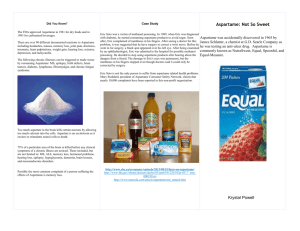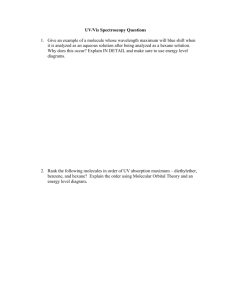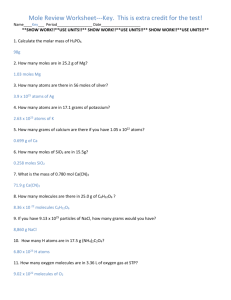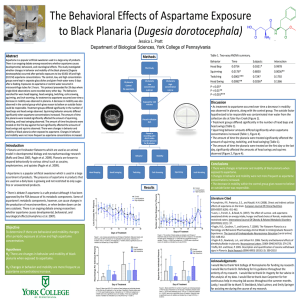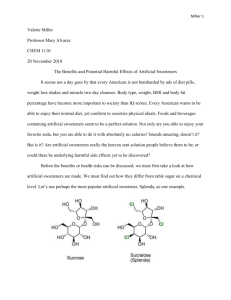Aspartame Poisoning
advertisement
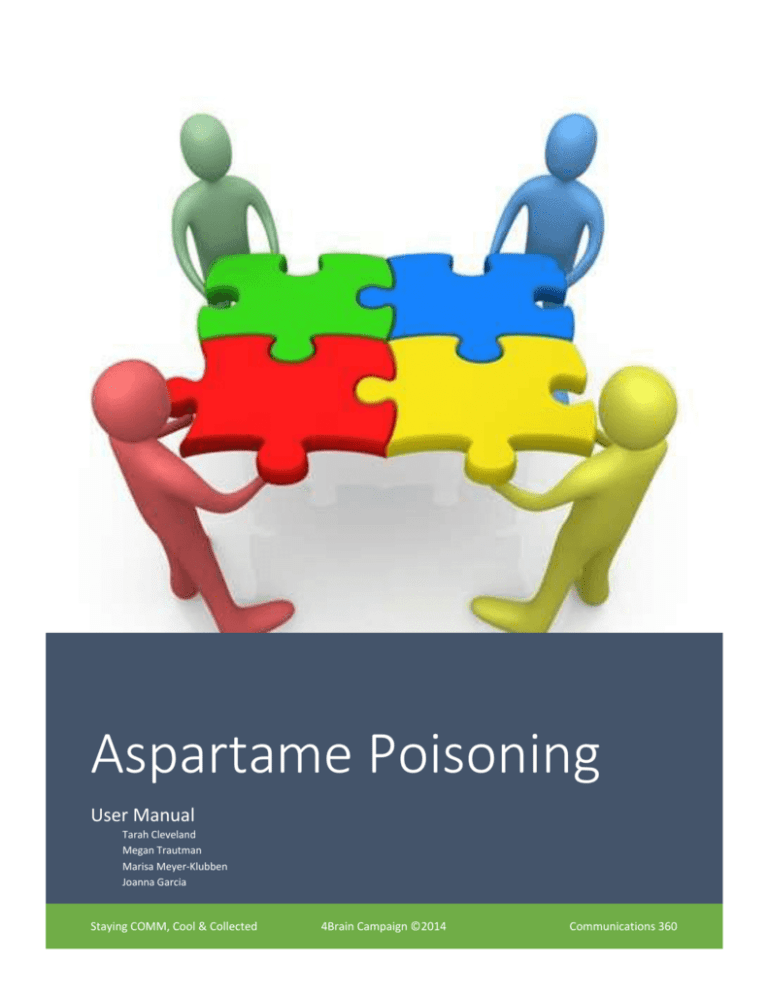
Aspartame Poisoning User Manual Tarah Cleveland Megan Trautman Marisa Meyer-Klubben Joanna Garcia Staying COMM, Cool & Collected 4Brain Campaign ©2014 Communications 360 1.0 ABSTRACT Aspartame is one of the world’s most well-known artificial sweeteners; it is 200 times sweeter than sugar and is used in over 6,000 foods and beverages consumed around the world (American Cancer Society, 2014). As of March 2013, the Food and Drug Administration (FDA) reported 10,000 complaints from people experiencing 92 symptoms caused by aspartame consumption (Webb, 2013). The excessive use of aspartame can be lethal, resulting in a condition called aspartame poisoning (American Cancer Society, 2014). The following report presents an introduction, a brief history, signs, symptoms, and treatments of aspartame poisoning. The report also includes survey results collected from faculty, staff, and students at Valley City State University (VCSU) about aspartame consumption as well as acceptable daily intakes of aspartame poisoning. The research conducted by the 4BrainCampaign suggests that aspartame may lead to other health complications in addition to aspartame poisoning. II 2.0 TABLE OF CONTENTS 1.0 ABSTRACT............................................................................................................ II 2.0 TABLE OF CONTENTS ............................................................................................. III 3.0 TOOLS & COMPONENTS......................................................................................... IV 4.0 PURPOSE, IMPORTANCE & SCOPE ............................................................................. V 4.1 ASPARTAME POISONING ...................................................................................... V 4.2 PURPOSE ......................................................................................................... V 4.3 IMPORTANCE .................................................................................................... V 4.4 SCOPE ............................................................................................................. V 5.0 KEY COMPONENTS OF ASPARTAME POISONING ........................................................... VI 5.1 INTRODUCTION ................................................................................................. VI 5.2 HISTORY ......................................................................................................... VI 5.3 FOODS ........................................................................................................... VI 5.4 SUMMARY ....................................................................................................... VI 5.6 FACT .............................................................................................................. VI 5.7 SIGNS & SYMPTOMS ......................................................................................... VII 5.8 TREATMENT .................................................................................................... VII 5.9 SURVEY & RESULTS .......................................................................................... VII 5.10 ANALYSIS ..................................................................................................... VII 6.0 QUESTION & ANSWER ......................................................................................... VIII 7.0 REFERENCES ........................................................................................................ IX 8.0 GLOSSARY .......................................................................................................... XI III 3.0 TOOLS & COMPONENTS The purpose of this manual is to educate audience members on aspartame poisoning by providing information the following components: - History of aspartame poisoning - Effects of aspartame on the body - Foods containing aspartame - Signs and symptoms of aspartame poisoning - Treatment for aspartame poisoning - *Research and responses from VCSU students, faculty, and staff survey *The 4BrainCampaign conducted a survey to gain insights as to what the average daily aspartame consumption is in relation to the acceptable daily intake. Our goal was to collect and analyze the obtained data to get a better indication of the likelihood or risk of aspartame poisoning on the VCSU campus. IV 4.0 PURPOSE, IMPORTANCE, & SCOPE 4.1 Aspartame Poisoning The research completed by the 4BrainCampaign resulted in definition, history, signs, symptoms, treatments, and conclusions of aspartame poisoning. Aspartame poisoning is like an allergic reaction. It is the human body’s reaction to the continuous use of the artificial sweetener aspartame (Smith, 1981). Aspartame consists of aspartic acid and phenylalanine. Aspartame was approved for use in foods in 1981 by the Food and Drug Administration (FDA); it is found in nearly 6000 foods sold in stores around the world; it may be found naturally in fruits and vegetables as well (Smith, 1981). 4.2 Purpose The purpose of this report is to make audience members aware of the aspartame contained in the everyday foods sold in stores and restaurants globally. The purpose of the aspartame poisoning presentation is not to eliminate all aspartame consumption. Aspartame consumption is inevitable because of its broad distribution. The presentation has been made to educate audiences on the signs, symptoms, and available treatments for aspartame poisoning. 4.3 Importance Since aspartame is so widely distributed and readily available, it is important to be educated on its harmful side effects to the human body. Aspartame may cause physical, neurological, gastrointestinal, and psychological complications in the body (Smith, 1981). These problems have been recognized by 92 different symptoms reported to the FDA (American Cancer Society, 2014). The audiences that read this manual and aspartame poisoning presentation may learn the warning signs and symptoms of aspartame. In addition, this report specifies the acceptable daily intakes of aspartame for humans based upon body weight. Those that are mindful of aspartame consumption may avoid aspartame poisoning as well as the damaging effects that aspartame may have on the body. 4.4 Scope The scope of this research is to deliver information to the course instructor and online students of Communications 360. The project was completed in coordination with the Valley City State University portfolio project requirements. The research conducted and presented incorporates secondary resources from the Internet. Primary research was also collected in the form of a survey including faculty, staff, and students of Valley City State University. This survey requested data on the aspartame consumption in a typical day and a typical week of the participants. V 5.0 KEY COMPONENTS OF ASPARTAME POISONING 5.1 Introduction Aspartame is an artificial sweetener that is used in place of sugar. Aspartame poisoning is the shock in the body that is created by overuse of aspartame. This poisoning can lead to serious side effects (Smith, 1981). 5.2 History “In one study, a group of 320 rats exposed to aspartame experienced 12 brain tumors, while the control had only one tumor—a disparity that my intuitively interesting but that all parties agree is not statistically significant” (Aspartame, p. 2). 5.3 Foods Aspartame is found in about 6000 products worldwide. This seems shocking, but perhaps what is more shocking is that aspartame is found in foods we consider to be healthy such as fruits and vegetables. However, fruits and vegetables contain very low amounts of aspartame when compared with carbonated beverages or sugar-free candies (Aspartame: How Is Aspartame Regulated, 2014). 5.4 Summary According to the American Cancer Society (2014), the Food and Drug Administration (FDA) has regulated the acceptable daily intake (ADI) of aspartame to 50 milligrams per kilogram of body weight. This means that an adult that weighs 165 pounds (75 kilograms) could consume 3,750 milligrams of aspartame per day. 5.5 Side Effects The systems of aspartame affect the body in many different ways including physically, psychologically, gastrointestinally and neurologically. 5.6 Facts Aspartame was discovered on accident in 1965 when James Schlatter, a chemist of G.D. Searle Company, was testing an anti-ulcer drug (Mercola.com, 2011). Aspartame accounts for over 75 percent of the adverse reactions to food additives reported to the FDA (Mercola.com, 2011). Aspartame is 40% aspartic acid, which is harmful to our health. It can cause a myriad of symptoms, but the most serious include neurological disorders (Mercola.com, 2011). Aspartame has 10% wood alcohol/poison and yet, it still is added to our foods. Aspartame was approved for use in soft drinks in 1983 (Mercola.com, 2011). VI 5.7 Signs & Symptoms Ninety-two different health symptoms were reported from aspartame consumption, according to the FDA. Physical, Neurological, Gastrointestinal, and Psychological/Psychiatric symptoms affect individuals from aspartame poisoning. 5.8 Treatment It can take up 6 weeks to a year to recover from Aspartame Poisoning. It all depends on how long the chemicals were used. 5.9 Survey & Results There were 82 participants in the survey. The average survey completion time was 4 minutes. Between 11% and 14% of participants completed the open response questions. Nearly 98% of participants completed the first question about daily aspartame consumption. Nearly 89% participants completed the second question on the survey regarding weekly aspartame consumption. 5.10 Analysis Table-top sweeteners, gelatin/pudding, and hot chocolate mix were the three least likely consumed products in a typical day. This seems interesting especially for college students that are likely to mix sweetener with the abundantly-consumed: coffee. Cereal, chewing gum, and juice drinks were the top three most likely consumed (1-3 times) products in a typical day. Chewing gum and carbonated soft drinks were the top two most likely consumed (4 or more times) products in a typical day. VII 6.0 QUESTION & ANSWER Q: What is the title of your group? A: 4BrainCampaign Q: What is your group’s slogan? A: “COMM, Cool & Collected” Q: Who are your group members? A: Tarah Cleveland, Joanna Garcia, Marisa Meyer-Klubben, and Megan Trautman. Q: What are your roles in the group? A: Tarah: Organizer. Joanna: Communicator. Marisa: Editor. Megan: Editor. Q: What method did you use to present your findings? A: PowerPoint presentation. Q: What topic did you research? A: The 4BrainCampaign researched aspartame and aspartame poisoning. Q: When was aspartame discovered? A: Aspartame was discovered in 1961. Q: What is the most surprising piece of information that you found? A: Aspartame is contained in around 6000 common foods. VIII 8.0 REFERENCES American Cancer Society. (2014). Retrieved December 6, 2014 from http://www.cancer.org/cancer/cancercauses/othercarcinogens/athome/aspartame Aspartame. (2014, May 28). Retrieved November 28, 2014, from http://www.cancer.org/cancer/cancercauses/othercarcinogens/athome/aspartame Aspartame Consumption. (November 29, 2014). Aspartame Information Center. (1985). Aspartame. Reactions 133.1. 2-6. Retrieved November 28, 2014, from http://www.aspartame.org/wp-content/uploads/2009Aspartamebrochure.pdf Aspartame Information Service. (2014). Retrieved from http://www.aspartame.net/?gclid=CMevzqGrcICFeE-MgodRxAA8A Aspartame Poisoning. (2014). MD Health. Retrieved from http://www.md-health.com/AspartamePoisoning.html Aspartame Side Effects. (2002). Retrieved from http://www.sweetpoison.com/aspartame-sideeffects.html Brahmini, M. et al. (2012, May-June). Myths and Facts about Aspartame and Sucralose: A Critical Review. IJRAP. Retrieved from http://www.ijrap.net/admin/php/uploads/808_pdf.pdf Consumer Products. (2014, January 1). Retrieved November 28, 2014, from http://www.aspartame.org/about/consumer-products/#.VHk6q43wvVJ Ellen Whipple Guthrie, P. (n.d.). Examining the Safety of Aspartame. Multiple Sclerosis Foundation. Retrieved from http://www.msfocus.org/article-details.aspx?articleID=40 Familydoctor.org editorial staff. (2010). What is Aspartame? Retrieved November 28, 2014 from http://familydoctor.org/familydoctor/en/prevention-wellness/food-nutrition/sugar-andsubstitutes/sugar-substitutes-what-you-need-to-know/aspartame-what-you-need-toknow.html?WT.srch=1&utm_source=google&utm_medium=cpc&utm_campaign=NB_GOOGLE_NONE_PS _US_Aspartame%20|%20Broad_KENS_CPC_SCH&utm_term=aspartame%20dangers Gennet, R. (2011). Donald Rumsfeld and the Strange History of Aspartame. Retrieved from Huffington IX Post: http://www.huffingtonpost.com/robbie-gennet/donald-rumsfeld-and-the-s_b_805581.html Gerson, C. (2006). Aspartame, NutraSweet, equal, spoonful: The Poison in some 5,000 food products. 21. Gerson Healing Newsletter. Retrieved Dec 12 2014 from http://www.thefreelibrary.com/Aspartame%2c+Nutrasweet%2c+equal%2c+spoonful%3a+the+Poison+in+ some+5%2c000+food...-a0169164797 Gold, M. D. (2002). Reported Aspartame Toxicity Effects. Retrieved from http://www.fda.gov/ohrms/dockets/dailys/03/jan03/012203/02p-0317_emc-000199.txt Novella, S. (2010). Aspartame: Truth vs Fiction. Retrieved December 1, 2014 from http://www.sciencebasedmedicine.org/aspartame-truth-vs-fiction/ Smith, J. (1981, August 28). Aspartame approved despite risks. 213. Science. doi:10.1126/science.7268411 Webb, G. (2013, March 19). Is the Artificial Sweetener Aspartame Really a Problem? The Legal Examiner. Retrieved December 6, 2014 from http://charlottesville.legalexaminer.com/toxic-substances/is-theartificial-sweetener-aspartame-really-a-problem/ X 7.0 GLOSSARY Aspartame- a white, crystalline, odorless, slightly water-soluble non-carbohydrate powder, C 14 H 18 N 2 O 5, synthesized from amino acids, that is 150–200 times as sweet as sugar: used as a low-calorie sugar substitute in soft drinks, table sweeteners, and other food products. Aspartic acid- a nonessential amino acid, C 4 H 7 NO 4, produced by the hydrolysis of asparagine and proteins, found chiefly in young sugar cane and sugar-beet molasses, and used in the preparation of culture media and as a dietary supplement. Symbol: D. Abbreviation: Asp; Gastrointestinal- of, relating to, or affecting the stomach and intestines. Eczema- an inflammatory condition of the skin attended with itching and the exudation of serous matter. Insomnia- inability to obtain sufficient sleep, especially when chronic; difficulty in falling or staying asleep; sleeplessness. Nausea- sickness at the stomach, especially when accompanied by a loathing for food and an involuntary impulse to vomit. Neurological- the science of the nerves and the nervous system, especially of the diseases affecting them. Phenylalanine- a crystalline, water-soluble, essential amino acid, C 6 H 5 CH 2 CH(NH 2)COOH, necessary to the nutrition of humans and most animals, obtained chiefly from egg white or skim milk. Symbol: F. Abbreviation: Phe; Phobias- a persistent, irrational fear of a specific object, activity, or situation that leads to a compelling desire to avoid it. Physical- of or relating to the body Psychological- of, pertaining to, dealing with, or affecting the mind, especially as a function of awareness, feeling, or motivation: psychological play; psychological effect. Seizures- a sudden attack, as of epilepsy or some other disease. Tremors- involuntary shaking of the body or limbs, as from disease, fear, weakness, or excitement; a fit of trembling. XI
